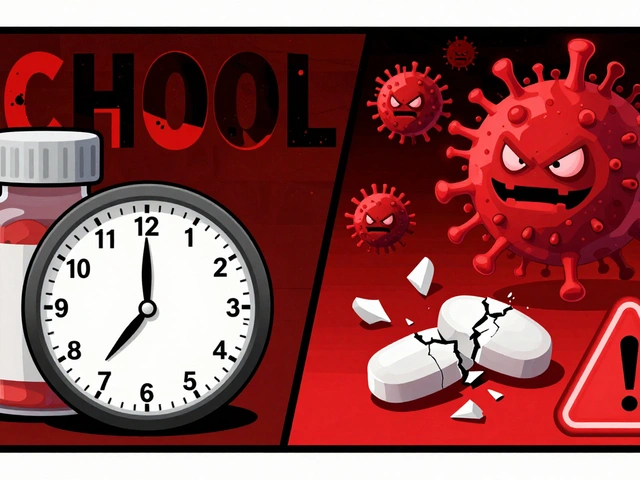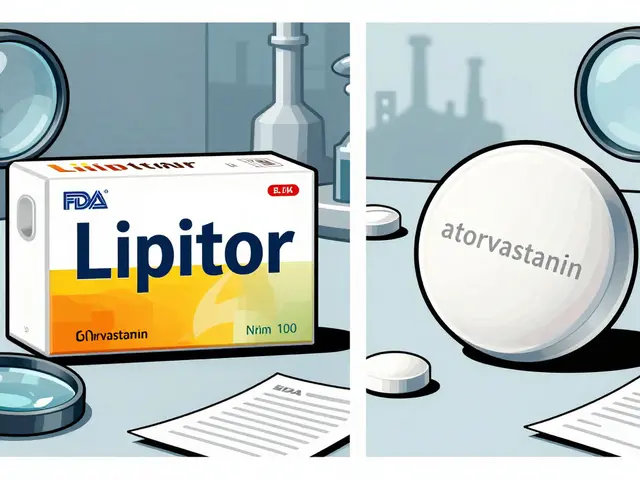Rescue Inhaler Selector
Find Your Best Rescue Inhaler
Answer a few quick questions about your asthma symptoms, preferences, and needs to get a personalized recommendation for the right rescue inhaler.
When an asthma attack strikes, the first thing you reach for is a fast‑acting inhaler. Ventolin inhaler has been the go‑to rescue medication for decades, but the market now offers several other options that promise similar relief with different side‑effect profiles or dosing convenience. This guide breaks down the most common alternatives, compares how quickly they work, how long they last, and what you should weigh before swapping your trusted inhaler.
What is the Ventolin (Albuterol) Inhaler?
Ventolin is a brand‑name short‑acting beta2‑agonist (SABA) inhaler that delivers albuterol directly to the lungs. It was first approved in the 1980s and quickly became the standard for on‑demand bronchodilation. The device uses a metered‑dose propellant (HFA) to spray a fine mist of Albuterol that relaxes airway smooth muscle, opening up constricted passages within minutes.
Typical dosage is two puffs (90 µg each) every 4‑6 hours as needed, not exceeding 12 puffs per day. Because it works fast-usually within 5 minutes-and its effects wear off after 4‑6 hours, it’s perfect for sudden wheezing or exercise‑induced symptoms.
How Albuterol Works
Albuterol binds to beta2 receptors on bronchial smooth muscle, triggering a cascade that increases cyclic AMP. The result is rapid muscle relaxation and airway dilation. This mechanism is shared by all SABAs, which is why many alternatives feel almost identical in action.
Common Alternatives to Ventolin
Below are the most frequently prescribed or over‑the‑counter rescue options. Each has its own onset time, duration, and side‑effect nuances.
ProAir HFA (generic albuterol)
ProAir is essentially the same molecule as Ventolin but sold under a different brand. It delivers 90 µg per puff with identical onset (1‑5 minutes) and duration (4‑6 hours). Many insurers list it at a lower co‑pay, making it a cost‑effective alternative for patients who don’t need a brand name.
Levalbuterol (Xopenex)
Levalbuterol is the R‑enantiomer of albuterol, meaning it’s a slightly purer version of the same drug. Clinical trials in 2023 showed a modest 10‑15 % reduction in tremor and tachycardia compared with standard albuterol, while retaining the same 2‑minute onset. The downside is a higher price tag-often 30‑40 % more than generic albuterol-and limited insurance coverage.
Ipratropium (Atrovent)
Ipratropium is an anticholinergic bronchodilator, not a beta‑agonist. It works by blocking muscarinic receptors, which reduces mucus secretion and smooth‑muscle contraction. Onset is slower (5‑10 minutes) and the effect lasts 4‑6 hours, similar to albuterol. It’s often paired with a SABA (e.g., Combivent) for patients who experience paradoxical bronchospasm with beta‑agonists alone.
Salmeterol (Serevent)
Salmeterol is a long‑acting beta2‑agonist (LABA). It has a slow onset (15‑30 minutes) but provides bronchodilation for up to 12 hours. Because it’s not fast enough for acute attacks, guidelines recommend using it only in combination with an inhaled corticosteroid for long‑term control, never as a rescue inhaler.
Formoterol (Foradil)
Formoterol bridges the gap between SABAs and LABAs. Its onset is rapid (1‑3 minutes), matching albuterol, yet its duration stretches to 12 hours. This makes it a popular choice for “SMART” therapy (single inhaler for both maintenance and rescue) in some countries, though it still requires an accompanying inhaled steroid.
Montelukast (Singulair)
Although not an inhaler, Montelukast is an oral leukotriene receptor antagonist used for chronic asthma control and exercise‑induced bronchoconstriction. It takes 2‑4 hours to start working and must be taken daily. It never replaces a rescue inhaler but can reduce the frequency of attacks, thus decreasing reliance on SABAs.
Side‑Effect Snapshot
All bronchodilators share some common adverse effects-tremor, jitteriness, fast heart rate-but the intensity varies.
- Ventolin / ProAir: mild tremor, possible throat irritation.
- Levalbuterol: lower incidence of tremor; still can cause palpitations.
- Ipratropium: dry mouth, bitter taste; no cardiac stimulation.
- Salmeterol / Formoterol: risk of paradoxical bronchospasm if used alone; must pair with steroids.
- Montelukast: rare neuropsychiatric events; generally well‑tolerated.
Quick Comparison Table
| Inhaler / Drug | Class | Onset | Duration | Typical Use | Cost (AU$) per inhaler |
|---|---|---|---|---|---|
| Ventolin | SABA | 1‑5 min | 4‑6 hrs | Rescue | 35‑45 |
| ProAir HFA | SABA | 1‑5 min | 4‑6 hrs | Rescue | 30‑38 |
| Levalbuterol | SABA (R‑enantiomer) | 2‑5 min | 4‑6 hrs | Rescue (tolerability focus) | 55‑70 |
| Ipratropium | Anticholinergic | 5‑10 min | 4‑6 hrs | Rescue/adjunct | 40‑50 |
| Formoterol | LABA (fast‑onset) | 1‑3 min | 12 hrs | SMART therapy (with steroid) | 70‑85 |
| Salmeterol | LABA (slow‑onset) | 15‑30 min | 12 hrs | Maintenance (with steroid) | 65‑80 |
| Montelukast | Leukotriene antagonist (oral) | 2‑4 hrs | 24 hrs | Daily control | 30‑40 |
How to Choose the Right Rescue Inhaler
Pick a device that matches your lifestyle and medical needs. Here’s a quick decision checklist:
- Speed of relief: If you need immediate bronchodilation (e.g., during exercise), stick with a SABA like Ventolin, ProAir, or Levalbuterol.
- Tolerability: Patients who experience shakiness on albuterol often switch to Levalbuterol or add Ipratropium.
- Cost & insurance: Generic albuterol inhalers are usually the cheapest; check PBS listings for Australian rebates.
- Frequency of use: If you find yourself needing a rescue inhaler more than twice a week, discuss adding a maintenance medication (e.g., inhaled corticosteroid, Formoterol‑based SMART plan).
- Device preference: Some prefer a breath‑actuated inhaler (Ventolin) over a metered‑dose inhaler (ProAir) for ease of use.
Proper Inhaler Technique - Get the Most Out of Your Medication
A poorly taken puff can feel like the inhaler isn’t working, prompting unnecessary extra doses.
- Shake the inhaler for at least 5 seconds.
- Exhale fully, but do not blow into the mouthpiece.
- Place the mouthpiece between your teeth, seal lips, and start a slow, steady inhale.
- Press the canister to release the dose at the beginning of the breath.
- Hold your breath for about 10 seconds, then exhale slowly.
- If you need a second puff, wait 30 seconds before repeating.
Cleaning the mouthpiece weekly with warm water prevents medication buildup and maintains dose accuracy.
When to Seek Medical Help
If you use your rescue inhaler more than three times in a 24‑hour period, or symptoms don’t improve within 15 minutes, call your doctor or go to the nearest emergency department. Persistent reliance on rescue medication often signals uncontrolled asthma, which may require stepping up maintenance therapy.
Frequently Asked Questions
Is Ventolin the same as generic albuterol?
Ventolin contains the same active ingredient-albuterol-as generic inhalers like ProAir HFA. The difference lies in branding, price, and sometimes the propellant system, but the clinical effect is identical.
Can I replace my SABA with a LABA for quick relief?
No. LABAs such as Salmeterol have a slow onset and are meant for long‑term control, not emergency relief. Using them alone can increase the risk of severe asthma attacks.
Why does my heart race after using Ventolin?
Albuterol stimulates beta2 receptors in the lungs, but it can also affect beta1 receptors in the heart, causing a temporary increase in heart rate. If this becomes bothersome, ask your doctor about Levalbuterol or adding Ipratropium.
Is it safe to use both Ventolin and Ipratropium together?
Yes, the combination (often found as Combivent) is approved for patients who need extra bronchodilation. The drugs work via different pathways, so they complement each other without increasing cardiac side effects.
Do I need a prescription for any of these alternatives?
In Australia, all SABAs (Ventolin, ProAir, Levalbuterol) and anticholinergics (Ipratropium) require a prescription. Some over‑the‑counter options exist in other countries, but always check local regulations.
Choosing the right rescue inhaler isn’t just about price-it’s about how quickly you get relief, how you feel after a dose, and how the medication fits into your overall asthma plan. Use this comparison as a starting point, talk to your respiratory therapist, and make an informed choice that keeps you breathing easy.







Lionel du Plessis
October 26, 2025 AT 18:33Albuterol acts on β2‑adrenergic receptors causing a cAMP surge and smooth‑muscle relaxation within seconds. The HFA propellant creates aerosol particles ideal for peripheral airway deposition. This pharmacodynamics profile explains the rapid onset of Ventolin and its generic counterparts.
Andrae Powel
October 26, 2025 AT 21:20When tremor or palpitations become noticeable after a rescue puff, a practical step is to space the doses by at least 30 seconds and monitor the response. If side‑effects persist, discuss with your provider a trial of levalbuterol, which has a reduced β1 activity and often less cardiac stimulation. Also, ensuring proper inhaler technique can cut the required dose by up to 20 %.
Jennie Smith
October 27, 2025 AT 00:06Hey asthma warriors – mastering that inhaler routine feels like a quick choreography. Shake it, inhale steadily, hold the breath, exhale, and repeat if needed. A smooth performance means the medication hits the target and you get relief faster. Keep practicing, and you’ll turn every rescue into a victory lap.
Anurag Ranjan
October 27, 2025 AT 02:53Ipratropium adds an anticholinergic pathway without the β‑adrenergic surge, so tachycardia drops. Onset is slower but the synergy with a SABA can be lifesaving in refractory cases. Just remember to allow five minutes before the next puff.
James Doyle
October 27, 2025 AT 05:40Ventolin has been the cornerstone of acute bronchodilation for decades, a fact that many newcomers to pulmonology overlook. The molecular mechanism hinges on β2‑receptor agonism, which triggers intracellular cyclic AMP elevation and relaxes bronchial smooth muscle. This cascade unfolds within seconds, delivering symptomatic relief that most patients equate with immediate freedom. However, the pharmacological equivalence of generic albuterol, such as ProAir, is often underappreciated, leading to unnecessary brand loyalty. Cost‑conscious clinicians should be aware that the active pharmaceutical ingredient and metered‑dose technology are virtually identical across these products. When selecting a rescue inhaler, clinicians must weigh more than just price; device ergonomics, patient dexterity, and inhalation technique play pivotal roles. The R‑enantiomer levalbuterol, while pharmacodynamically similar, boasts a modest reduction in tremor and tachycardia, a benefit that may justify its higher price for select patients. Yet, the evidence base does not support universal substitution, as randomized trials reveal only marginal differences in clinical outcomes. For patients who experience paradoxical bronchospasm with β‑agonists, adjunctive anticholinergics like ipratropium provide an alternative pathway without stimulating cardiac β1 receptors. Salmeterol and formoterol, classified as LABAs, introduce a different therapeutic paradigm, offering prolonged bronchodilation but sacrificing the rapid onset necessary for acute rescue. The SMART approach, pairing a rapid‑onset LABA with an inhaled corticosteroid, exemplifies modern asthma management but requires strict adherence to guidelines. Moreover, the oral leukotriene receptor antagonist montelukast serves as a preventive agent, reducing baseline inflammation but never replacing an SABA for emergency relief. Physicians should also emphasize the importance of proper inhaler technique; suboptimal usage can mimic device failure and prompt unnecessary dose escalation. Routine counseling on shaking, breath coordination, and mouthpiece cleaning can preserve drug delivery efficiency. Finally, patients exceeding three rescue puffs in a 24‑hour window should be evaluated for uncontrolled asthma and potentially stepped up to maintenance therapy. In sum, while Ventolin remains a reliable rescue, the therapeutic landscape offers nuanced alternatives that merit individualized consideration.
Edward Brown
October 27, 2025 AT 08:26They keep the propellant formula under wraps because it could reveal how inhaler aerosols affect micro‑particle dynamics in the lungs and possibly influence immune response unbeknownst to the public. Some suggest that the HFA components might interact with environmental chemicals creating sub‑clinical inflammation. The pharmaceutical lobby pushes rapid‑onset SABAs as the only safe option while downplaying long‑acting agents that could reduce overall rescue use. In the end the real agenda is profit not patient autonomy.
ALBERT HENDERSHOT JR.
October 27, 2025 AT 11:13Ensuring consistent inhaler technique is a cornerstone of effective asthma control; a brief demonstration can highlight common errors such as inadequate breath hold or failure to prime the device. Encourage patients to perform the “shake‑breathe‑hold” routine daily, and suggest a follow‑up check after each refill. This proactive approach often reduces rescue inhaler usage and improves quality of life. Keep reinforcing the habit and celebrate small gains :)
Suzanne Carawan
October 27, 2025 AT 14:00Oh absolutely, splurging on the premium R‑enantiomer will miraculously cure every tremor and make your asthma disappear, because chemistry always obeys your wallet.
Kala Rani
October 27, 2025 AT 16:46Price tags don’t dictate efficacy; sometimes the plain generic works just as well as the fancy brand.
Donal Hinely
October 27, 2025 AT 19:33Spare us the theatrics – tossing sarcasm around doesn’t change the pharmacology. If a patient can’t afford levalbuterol, they still have albuterol, which does the job. Let’s keep the debate factual instead of flamboyant.
Cheyanne Moxley
October 27, 2025 AT 22:20Thanks for the pep talk but I’m still stressed about hitting that third puff at night, feels like I’m drowning even with the “proper” technique.